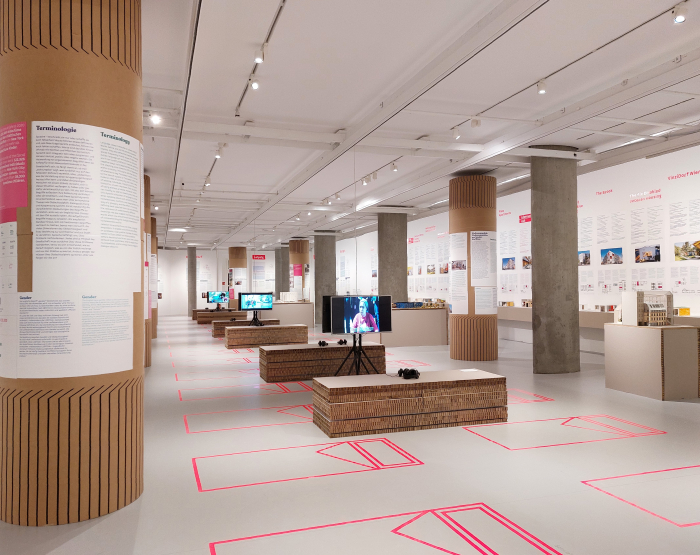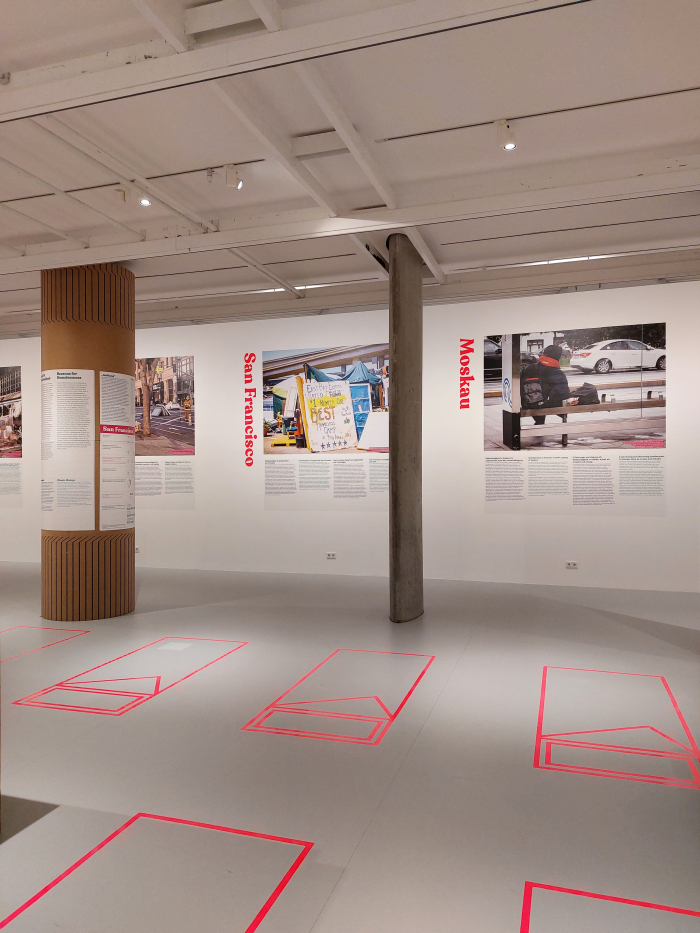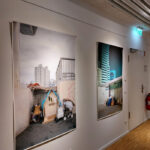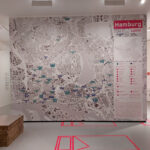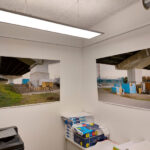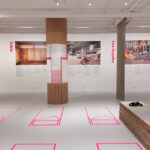Who’s Next? Homelessness, Architecture and Cities at the Museum für Kunst und Gewerbe, Hamburg
Globally some 100 million individuals are classed as homeless, with untold millions more living in precarious, unsafe, unhealthy conditions.1
And the problem isn’t new. Just one of the great many that as a global society we’ve never managed to get on top off.
With the exhibition Who’s Next? Homelessness, Architecture and Cities the Museum für Kunst und Gewerbe, Hamburg, both offer insights into global homelessness and also demand fresh impetus for finding more meaningful ways forward…….
As an exhibition Who’s Next? Homelessness, Architecture and Cities is, in effect, a triptych, a composition in three sections which although all independent, intrinsically combine with and extend one another to form a whole that is more than the sum of its parts. Technically its a tetraptych, a four parter, or more accurately a pentaptych, a five parter, but we’ll get to that.
As befits a triptych, a tetraptych, a pentaptych, Who’s Next? is an exhibition with no natural starting point, no section which must be studied first, rather is one that invites you to dive in and then find your own way through and amongst, and for all continually back-and-forth between, the three, four, five sections, the interplay between its component parts being the key to is agency; however, that said, and meant, arguably, it makes most sense to start with the discussions on some of the myriad aspects that congregate under and thereby compose the apparently simple term “homelessness”. Discussions presented in Who’s Next? as fly-posters on stylised Litfaßsäulen, urban advertising columns, one could argue other entities which live on all our streets but which most of us take but only cursory notice of2; and fly-posters which cover subjects such as, for example, and amongst others, the demographics of homelessness, or health and well-being aspects of homelessness, or community and self-organisation by and amongst homeless individuals. If one so will global aspects in and of both the existence and persistence of homelessness.
And brief discussions on global aspects which flow into the, by our counting, second section of the triptych, tetraptych, pentaptych, and its exploration of local, regional issues surrounding homelessness and local, regional responses to homelessness, including brief explorations of contemporary homelessness in cities as diverse as, and amongst others, New York, Moscow or Shanghai, and also via a geographically and economically wide ranging German focus through brief explorations of aspects of homelessness and responses to it in, for example, Leipzig, Munich, Essen or Stuttgart. A section, an opportunity to consider and reflect upon local realities in context of global aspects, which helps underscore that for all that homelessness is a ubiquitous global phenomenon, homelessness isn’t homelessness, isn’t homogenous, and is certainly not something that can be defined and approached in universal, definitive terms. If similarities and intersections can be located. If always in specific local contexts. And always in context of the individual. Individuals who all too often are also treated as but a component of an homogenous mass. And not as individuals.
The third section of the triptych, tetraptych, pentaptych, again in our counting, in our viewing of Who’s Next?, is devoted to 19 housing projects which seek in various and varied ways to alleviate not only homelessness but the myriad aspects that congregate under and thereby compose the apparently simple term “homelessness”; housing projects in many regards extended and expanded by introductions on the neighbouring Litfaßsäulen to a selection of international, community wide, projects which in their own ways seek to tackle aspects of local homelessness. Community wide projects such as, for example, Seattle Public Library, an institution which aside from providing a space formally and conceptually designed to actively welcome, and offer assistance to, homeless individuals, also provides decentralised services for the homeless throughout the city; the La Ferme du Rail project in Paris, a community urban farming platform which in addition to seeking more sustainable solutions to food supply in contemporary cities, also provides accommodation and work for homeless individuals, with the aim of helping them become former homeless individuals; or the Mausoleo Memorial Dignidad in Santiago de Chile, an institution established to provide a dignified burial for homeless individuals. Which, yes, one could consider a little late to start thinking about dignity, or could understand as a very good stimulus to ask how much dignity we all, individually and collectively, afford the living homeless? And to ask if the dead homeless are perhaps easier to accept in our civilised, advanced, materialistic, instantaneous contemporary societies than the living homeless? Or are we simply better able to, more willing to, recognise dead homeless as individuals distinct from the homogenous problem of the living homeless?
And housing and community projects which bring one back to the Litfaßsäulen and their fly-posters and their statistics and their discussion points. And also back to the triumvirate found in the exhibition’s subtitle: homelessness, architecture and cities.
Specifically in terms of the constellations “homelessness and architecture” and “homelessness and cities”.
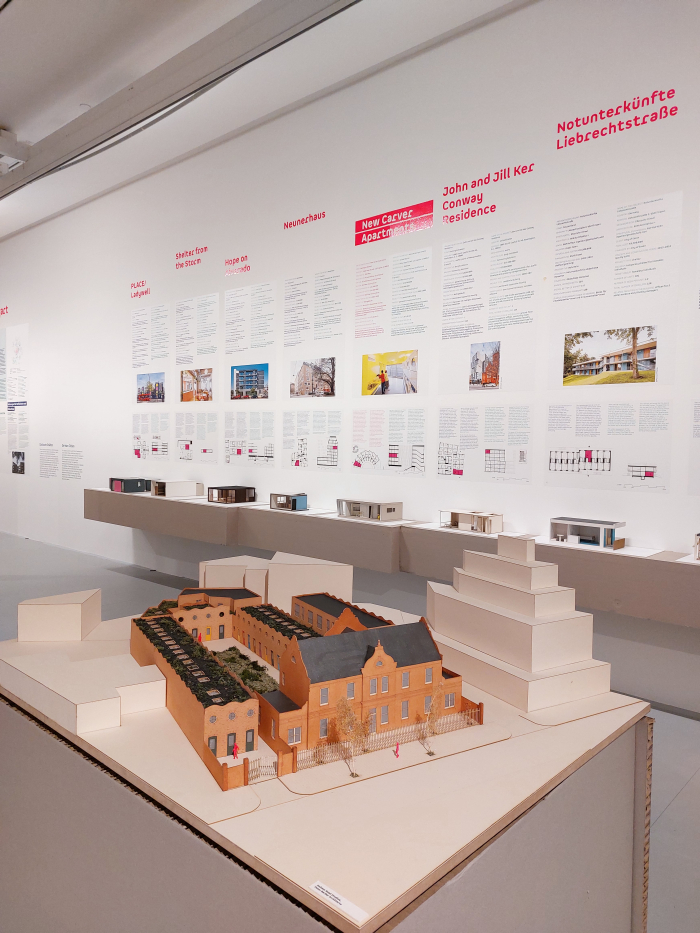
A model of Holmes Road Studios London by Peter Barber Architects for LB Camden and GLA Funding, as seen at Who’s Next? Homelessness, Architecture and Cities, Museum für Kunst und Gewerbe, Hamburg
In terms of the latter, Who’s Next? tends to a convincing argument that we need to learn to develop urban spaces that accept and accommodate and support those without a home, while not ignoring the needs and requirements of the majority who do have a home. Urban spaces, cities, we’re currently not very good at developing. And a subject which encompasses not only buildings and spaces and parks, but also urban furniture; a component of the discussion briefly covered in Who’s Next? via the fly-poster Hostile Architecture, and also via a brief discussion on the project Solidarische Infrastrukturen realised by Moritz Neumann, Paul Haas and Felix Röttger at the TU München, which, and as with the project Hidden Hostility by Theresa Güldenberg and Magdalena Meißner as presented in context of Sitting reconsidered. Design, Observe, Stage at the Burg Galerie, Halle, seeks to highlight, and thereby enable a discussion on, the fact that a great many contemporary city authorities actively make their urban furniture as inaccessible as possible for the homeless. And thus actively aiming to keep the homeless on the move, to make life as hard as possible for the homeless. Which hardly seems fair. Certainly not social. Nor dignified. Nor promoting of dignity. And succinctly focusses attention on the above posed question of the acceptance, or otherwise, of the living homeless in our civilised, advanced, materialistic, instantaneous contemporary societies. The acceptance, or otherwise, of the living homeless in our contemporary cities.
Considerations and reflections on homelessness and cities brought sharply into focus by the 43 sleeping bags hung over a section of the museum staircase: one sleeping bag for each of the 43 homeless individuals who lost their lives in Hamburg in 2021. The dignity, or otherwise, of their burial sadly isn’t recorded. What is recorded is that Hamburg wants to have eradicated homelessness within its borders by 2030.
And considerations and reflections on homelessness and cities, on homelessness and urban spaces, on homelessness and urban furniture, on Hamburg’s promise to eradicate homelessness by 2030, on dignity, initiated in and by Who’s Next?, that you are not only very much invited to continue outwith the walls of the Museum für Kunst und Gewerbe, but can’t avoid continuing, unless that is you actively avert your eyes: the Museum für Kunst und Gewerbe’s location next to Hamburg’s main railway station and main bus station, locations near ubiquitously associated with urban homelessness, meaning that before and after your visit to Who’s Next? aspects of, indications of, a brief taste of, the reality of homelessness in that climatically most unforgiving of European cities are readily accessible.3 Aspects of, indications of, a brief taste of, readily augmented and intensified by the briefest of walking tours through Hamburg. Again if undertaken with eyes wide open, certainly with wider open eyes than those with which we all normally drift through any city with which we claim familiarity, intimacy even. And free of the tourist gaze with which we all view any city for the first time.
Thereby making the city, Hamburg, very much the fourth section of the Who’s Next? pentaptych; a section which not only reminds you that the discussions undertaken in the warmth, comfort, security, wealth of the Museum für Kunst und Gewerbe are real, acute, and not theoretical academic distractions for an afternoon, but also of the privilege of being able to consider them in the warmth, comfort, security, wealth, academia of a museum and not through the discomfort of your own being. And which thus also enables you not only to reflect on the relationships between homelessness and the Kunst and Gewerbe of the museum’s name, and the relationships between homelessness and the 19th century society in context of which the museum was founded and arose, but also to reflect on the place of the contemporary Museum für Kunst und Gewerbe, the place of all contemporary museums, in tackling, responding to, contemporary urban homelessness. Are museum’s collectors of the artefacts and rituals of society past, or an active component of society present?
And reflections and considerations on “homelessness and cities” won both in the museum and on the streets which segue very neatly into reflections and considerations on “homelessness and architecture”.
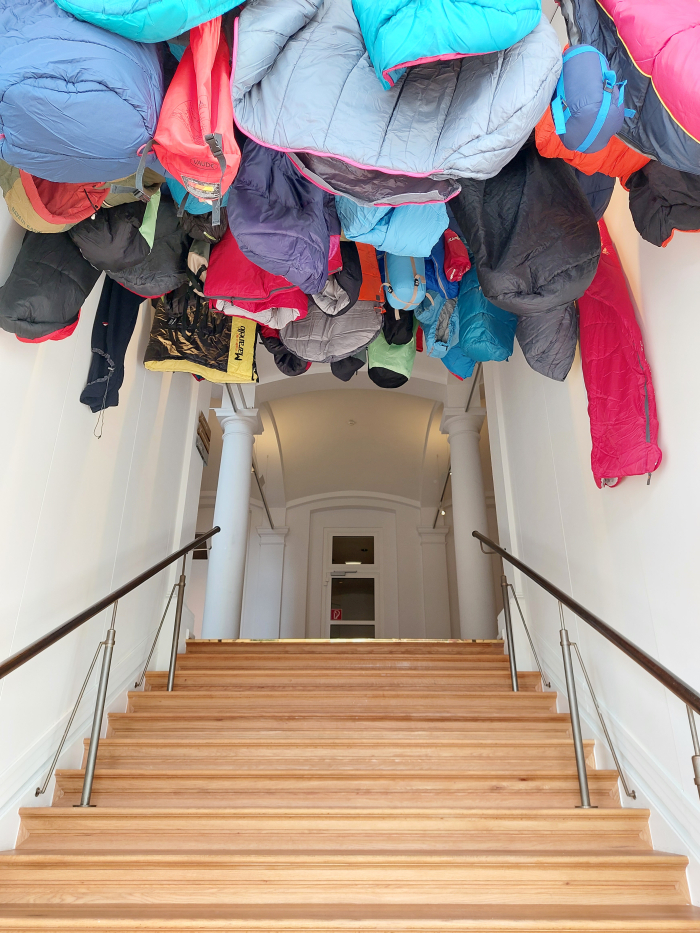
43 empty sleeping bags for 43 deceased homeless, as seen at Who’s Next? Homelessness, Architecture and Cities, Museum für Kunst und Gewerbe, Hamburg
Whereby one notes the word in the exhibition title is Architecture, not Architects. Or perhaps more accurately, not: Those who have studied and professionally practice the institutionalised profession of the architect.
Not that professional architects aren’t present in Who’s Next?, they very much are. And are very much celebrated. Are very much raised above the social workers, housing professionals, health care professionals, volunteers, homeless, et al who also contribute and contributed to the 19 featured housing projects and the selected international community wide projects. Yet despite the curators best efforts to place professional architects at the centre of the discussion, as the key to solving global homelessness, the presence of the professional architects, when reflected on and considered in context of the wider discussions and presentations, and in context of the streets of Hamburg, very neatly underscores that while professional architects can help develop spaces for projects aiming to alleviate and respond to homelessness, professional architects cannot solve homelessness4; indeed the focus in the discussions of the 19 presented projects is very much the architecture, the architects’ positions, the projects in context of contemporary architecture positions and approaches, any link in the discussions to homelessness is cursory, fleeting, indirect and at times almost insulting. Yes, it did annoy us. And, yes, we could continue complaining for hours. But won’t…… And the presence of the professional architects, when reflected on and considered in the myriad wider contexts, also neatly underscores that all too often professional architects contribute to homelessness through their involvement in egoistic, representative projects that primarily aim to serve the financial and power interests of a very small number of individuals with no regard for the consequences for the wider majority, for the communities in which they place their expensive visions. And, increasingly invariably, place their asocial, ostracizing, hostile, urban furniture. When a Victor Papanek opined that “there are professions more harmful than industrial design, but only a very few of them”5, the profession of the architect can, surely, be considered one of the few.
However, as we all know, architecture doesn’t need professional architects; a fact ably demonstrated by the fifth section of the Who’s Next? pentaptych: a presentation, staged a short walk from the Museum für Kunst und Gewerbe in the offices of the street newspaper and homeless advocate association Hinz&Kunzt, of photos by Munich based photographers Ulrike Myrzik and Manfred Jarisch of homeless, of homelessness, in Tokyo, the sort of place that as a European one finds very hard to imagine has homeless issues. A popular view of Japanese society which very neatly underscores the limitations, prejudices, stereotyping, generalisations, inaccuracies that form the basis of all our understandings of countries and regions and peoples other than our European own, the narrowness, and arrogance, of our European view of that world. And by extrapolation underscores the narrowness, and arrogance, of those views of homelessness, of the homeless, a greater many of the majority who have never been without a home invariably posses.
And while photographing homeless, homelessness, is, clearly, a sensitive subject, the photos do allow not only for a visibility of the issue, confirm that it not only exists but isn’t a passing state of affairs, is ongoing; but also allow for a focus to be placed on the structures and solutions the homeless themselves have developed in response to their realities, including, alongside a variety of both makeshift temporary shelters and more permanent structures, some examples of simple cardboard structures which define individual space in a public domain more than they provide shelter, define the individual in the mass, and also a storage unit, a storage system one could argue, crafted from waste materials, which, as with the space defining cardboard, helps underscore that the homeless need much more than shelter. And thereby represents an architecture without professional architects which although it will never feature in any glossy magazine or eye-wateringly expensive coffee table book, far less bring wealth and fame and fawning adulation to its creators, provides, or at least appears to provide, very meaningful responses to the direct issues faced, and that without negatively impinging on anyone else. And which helps underscore that not only is architecture without architects possible, but that responses to homelessness are very possible without architectural theory, one could argue without architecture. As with architects, architecture can assist projects, but can’t solve homelessness. Something tending to be reinforced back in the Museum für Kunst und Gewerbe by the numerous projects initiated by homeless individuals themselves, including three squats: projects in Leipzig and Cologne which, as far as we can ascertain are still ongoing, and one in Dresden from which the squatters have since been evicted. Squats, empty buildings, which pose innumerable further questions about the relationships between homelessness and architecture, homelessness and cities, homelessness and urban planning, homelessness and public authorities, homelessness and financial speculation.
And in doing also allows one to appreciate that there is a fourth term missing from the exhibition’s subtitle.
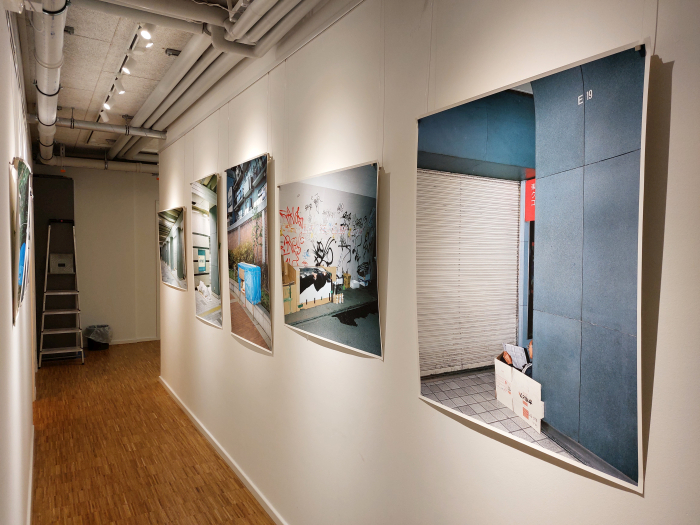
Photos of homelessness in Tokyo by Ulrike Myrzik and Manfred Jarisch in the offices of Hinz&Kunzt, as seen at Who’s Next? Homelessness, Architecture and Cities, Museum für Kunst und Gewerbe, Hamburg
Conceived by, and originally shown at, the Architekturmuseum der TU München, Who’s Next? is a very accessible and clearly formulated presentation; and a very text heavy presentation, there is a lot to read, certainly in those three sections staged within the Museum für Kunst und Gewerbe. Which, as ever, is in no way a complaint, far from it; on the one hand, much as architecture exhibitions famously must face the question how to present something that can’t be reproduced in a museum, so discussing a subject such as homelessness within museal confines brings with it challenges, to which we’d argue the text heavy Litfaßsäulen are, for a host of reasons, a most satisfying solution. And on the other hand, in our increasingly visual, and increasingly aural, world it is important that we all are regularly obliged to read more than five words and to practice turning that which we read into thoughts, arguments, positions and actions. Not just likes. No matter how 😍 you may find any given exhibition.
The numerous, bilingual German/English, texts being ably supported by a number of films exploring aspects of and responses to homelessness in a variety of locations; by models of various projects, which although, as noted above, primarily about the architecture, the architect’s approach to the provision of affordable, sustainable, responsible housing and communal living, do allow for insights into some local projects, or at least local projects in Europe and the USA, as a presentation its geographic reach is very restricted, and thereby provide a stimulus for better informing yourself of realities in those locations; by a small library for further reading, or, more hopefully, an impetus for books to purchase to continue your reading at home; by a map of Hamburg detailing homeless infrastructure, including note of the but 1 dermatologist, but 1 hairdresser and but 5 overnight hostels available for Hamburg’s ca. 2000, and apparently growing, rough sleepers6, a rapid growth in recent years which doesn’t bode well for 2030. And which all combine to create a nicely differentiated context in which to explore contemporary global homelessness.
And which for all helps one better appreciate that homelessness is a social issue, a public health issue, and thereby helps one better appreciate that if we want to find meaningful, durable, solutions to homelessness we need to stop seeing thinking of homelessness as being a question of housing provision, that is but one aspect; and for all Who’s Next? helps one better appreciate that we need to stop thinking of homelessness as a problem and start seeing it as a condition, a symptom. And to tackle the root causes. Not the symptoms.
Prevention being, as we all know, better than cure. In all contexts.
And demands we all consider how.
As an exhibition, as a triptych, a tetraptych, a pentaptych Who’s Next? reminds us, admonishes, that homelessness and tackling homelessness is the responsibility of us all, individually and collectively. For all that it is very easy to criticise architects and architecture and urban planning and property speculators and investment banks for the damage, for the problems, they develop, who enables such projects? Who doesn’t stand up and question the whats, whys and wherefores of large scale architecture and urban planning? Who let’s hostile urban furniture be installed throughout our cities? Who all too often averts their eyes from the world around them? Who all too often locates the problem in others? Yup, us all.7
As an exhibition, as a triptych, a tetraptych, a pentaptych, and for all through the interaction of its five component panels, the effortless manner in which the five sections combine with and extend one another, Who’s Next? enables one to approach an appreciation that while architectural design can play an important role in realising projects, the more important design task is the design of societies, the design of our social fabric, social textile design, so that homelessness not only isn’t blithely accepted, doesn’t exist unseen all around us like Litfaßsäulen, but isn’t possible, simply can’t happen. And while Who’s Next? tends to imply weaving such a social fabric is a very complicated challenge, it also tends to argue that it’s not impossible. But does involve us all, collectively and individually, altering our perspective on homelessness. And involves us all, collectively and individually, accepting our role in the existence and persistence of homelessness.
And thus having viewed Who’s Next? one understands that the full title should really be Who’s Next? Homelessness, Architecture, Cities and Society. And that for homelessness to be eradicated, the other three need to change.
Who’s Next? Homelessness, Architecture and Cities is scheduled to run at the Museum für Kunst und Gewerbe, Steintorplatz 20099, Hamburg until Sunday March 12th
Full information, including information on opening times, ticket prices, current hygiene rules, and details of the accompanying fringe programme can be found at www.mkg-hamburg.de
The Hinz&Kuntz photo exhibition can be viewed in the Hinz&Kunzt-Haus, Minenstraße 9, 20099 Hamburg until Friday February 10th. As far as we are aware the opening times are Monday – Friday 0930 – 1300 and 1400 – 1700. Hinz&Kunzt also offer walking tours through Hamburg for anyone keen to better appreciate the realities of homelessness in the city. Please check the Hinz&Kuntz website for more information.
In addition until Sunday March 5th the MKG is presenting Care for the Stock. Ten Strategies for Architecture, which although we haven’t seen in Hamburg we did see at the Deutsche Architektur Zentrum, Berlin and see no reason to doubt it is any less entertaining and informative and stimulating in the Museum für Kunst und Gewerbe.
- Who’s Next? Homelessness, Architecture and Cities, Museum für Kunst und Gewerbe, Hamburg
- Photos of homelessness in Tokyo by Ulrike Myrzik and Manfred Jarisch in the offices of Hinz&Kunzt, as seen at Who’s Next? Homelessness, Architecture and Cities, Museum für Kunst und Gewerbe, Hamburg
- A model of Star Apartments, Los Angeles, by Michael Maltzan Architecture for Skid Row Housing Trust, as seen at Who’s Next? Homelessness, Architecture and Cities, Museum für Kunst und Gewerbe, Hamburg
- 19 housing projects, as seen at Who’s Next? Homelessness, Architecture and Cities, Museum für Kunst und Gewerbe, Hamburg
- The Glowing Homeless by Fanny Allié, as seen at Who’s Next? Homelessness, Architecture and Cities, Museum für Kunst und Gewerbe, Hamburg
- A map of the infrastructure for homeless persons in Hamburg, as seen at Who’s Next? Homelessness, Architecture and Cities, Museum für Kunst und Gewerbe, Hamburg
- Architecture without architects in Tokyo, photos by by Ulrike Myrzik and Manfred Jarisch in the offices of Hinz&Kunzt, as seen at Who’s Next? Homelessness, Architecture and Cities, Museum für Kunst und Gewerbe, Hamburg
- A model of Lebensraum o16 in Frankfurt by Michel Müller, Heiner Blum, Jan Lotter & HKS Architekten for Frankfurter Verein für soziale Heimstätten, as seen at Who’s Next? Homelessness, Architecture and Cities, Museum für Kunst und Gewerbe, Hamburg
- Who’s Next? Homelessness, Architecture and Cities, Museum für Kunst und Gewerbe, Hamburg
1. Figure quoted in Who’s Next?, alongside an estimate of some 1.6 billion in precarious, unsafe, unhealthy accommodation. Whereby it is important to note, as Who’s Next? does, that legal definitions of homeless vary greatly amongst nations, as does the methodology by which one is recognised as such, thereby making any estimates on global homeless numbers essentially impossible, allowing for at best a rough estimate.
2. In its early years the British campaigning street newspaper The Big Issue ran a cartoon series called The Road Cones, objects chosen as protagonists because, as with the homeless, road cones live on urban streets but their ubiquity makes them invisible to most residents, unless that is you were directly faced with them, when they became a problem. The Litfaßsäulen are pleasingly reminiscent. If it is very, very depressing that after some 30 years such an analogy still works, and thus a depressing reminder of, despite the great amount of very good and very important work The Big Issue has undertaken, and the many similar projects that have since sprung up globally, how little has changed since The Big Issue first appeared.
3. Including the all too visible reality of the consequences of drug addiction, for all opioid addiction, that exist next to the Museum für Kunst und Gewerbe in August-Bebel-Park. Drug addiction and homelessness, addictions of all types and homelessness, being when not mutually inclusive then certainly long standing colleagues with a well established, and brutal, rapport.
4. In the interest of fairness there is a poster in the exhibition which states that architects can’t solve homelessness. But the presentation of the 19 projects very much places the architect at the centre, the tenor being very much that they are architecture projects and that the architect’s approach is the key to their success, that that without which they would probably have failed. An argument we would, and do, contest. Much as any number of disparate solutions can lead to a feasible, meaningful, successful, office building, school building or private home, so with projects aimed at alleviating homelessness. And much more important in alleviating homelessness is the concept housed in the architect’s work and the staff who seek to make it work.
5. Victor Papanek, Design for the Real World. Human ecology and social change, Thames & Hudson, 1985, Preface In the interests, again, of fairness Papanek contends that only advertising designers are worse than industrial designers, the claim about architects is ours. But, we’d argue, a great many of Papanek’s arguments for the dangers of industrial designers can be applied, when in an abstracted manner, to architects. And also argue that advertising isn’t design.
6. According to a poster in Who’s Next? in 2019 there were an estimated 1,910 rough sleepers in Hamburg and 4,666 homeless housed in shelters. The figures representing respective rises of 85.6% and 59.6% over the figures from 2009. What the figures are today we know no, but we do know that 2030 is getting ever closer.
7. We did intend bringing autonomous cars, flying taxis and delivery drones in at this stage, but decided against it. But do also see such and similar as very much part of the problem. And those companies who for no obvious reason deliver your groceries in 10 minutes. It may be possible, but is it advisable? Honestly…..?
Tagged with: Hamburg, Homelessness, Homelessness Architecture and Cities, mkg, Museum für Kunst und Gewerbe, Who‘s Next?
